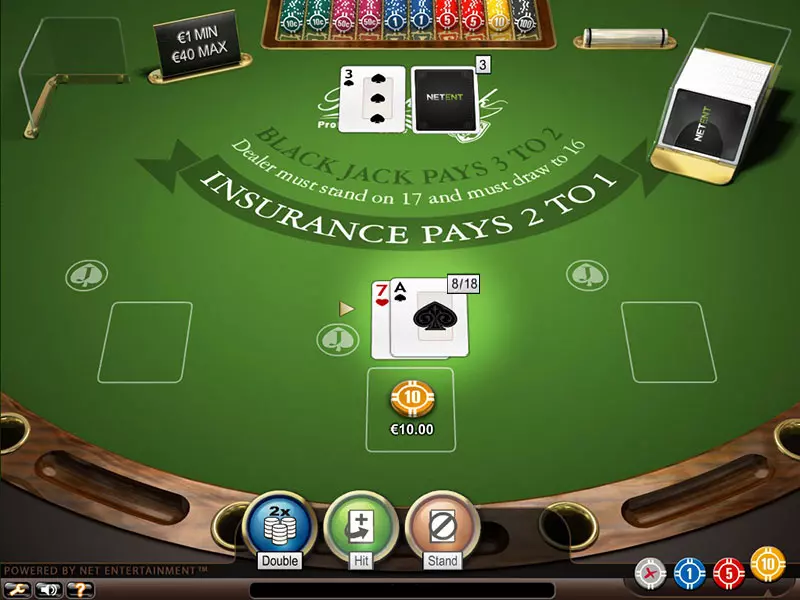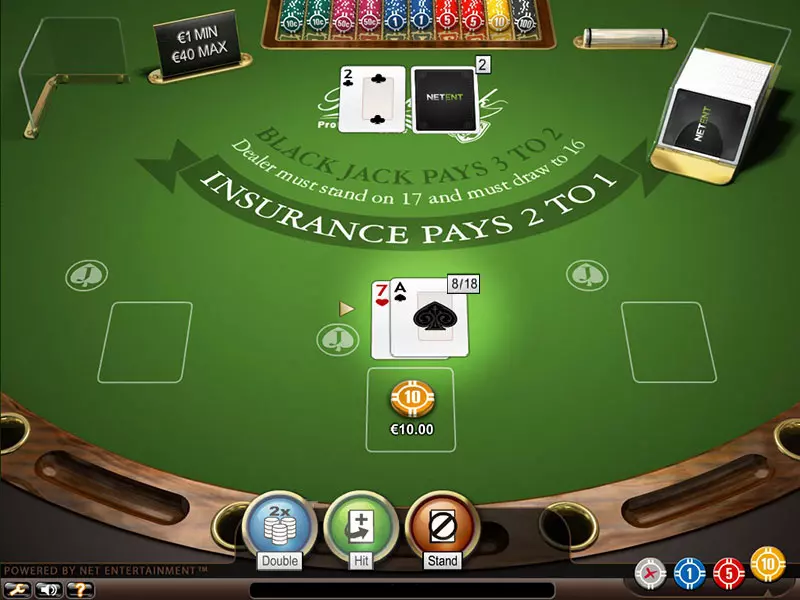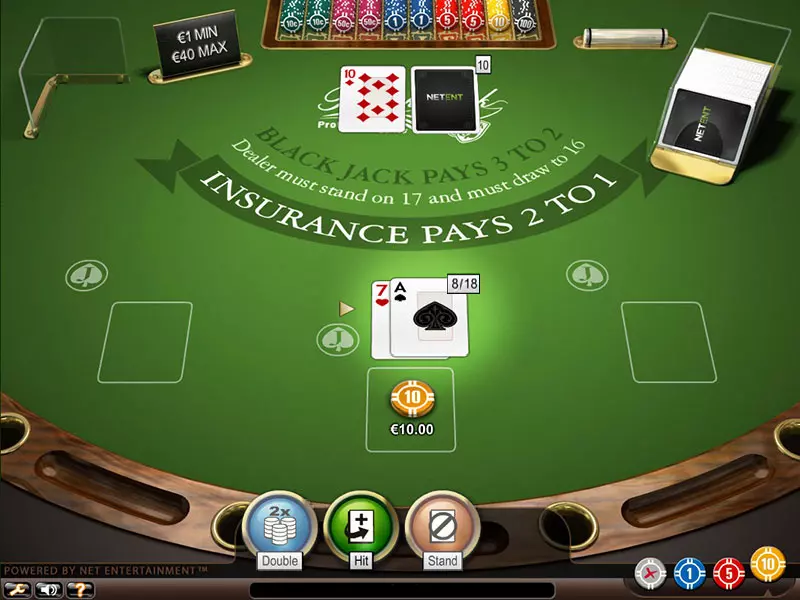Many players, even the ones who have been playing for years, underestimate the importance of getting familiar with all of the terms in blackjack. Some of them don’t even know that the phrase soft hands exists, what is left for its meaning and deeper understanding.
If players aim to leave the casino as winners, they need to devote a considerable amount of time to have a look at every possible hand they can get and how to proceed in a particular situation.
Players can form soft hands in several ways and as already mentioned some of them won’t even realise they have such a combination. It is crucial for players who want to master the game to try and acquire as much knowledge as possible.
In this chapter, we will focus on one particular occasion when players have soft 18. The reason why is that if gamblers want to make the best choice every time, they need to be aware of all the possible hands they can get.
Additionally, they need to follow a reliable strategy and know it by heart so that they can apply it whenever needed. It is true that if players want to master blackjack they need to put a lot of time and effort. In the end, they will certainly be glad of what they have achieved as the game really pays off in the long run.
| Soft 18 Basic Strategy Chart for Multi-Deck Games and Single-Deck H17 Games | ||||||||||
|---|---|---|---|---|---|---|---|---|---|---|
| Players’ Hand | Dealer’s Upcard | |||||||||
| 2 | 3 | 4 | 5 | 6 | 7 | 8 | 9 | 10 | Ace | |
| A-7 | S | Ds | Ds | Ds | Ds | S | S | H | H | H |
When the Dealer’s Upcard Is 3 through 6
Soft 18 falls into the category of one of the most frequently misplayed hands in blackjack. With this hand, you have a total of 18 that contains an ace which can be designated value of 11 without the hand going over 21. If players have an ace and a 7, then they have a soft 18 hand.
Other examples of soft 18 include multi-card hands such as 4-3-A, A-2-5, and A-6-A. The basic strategy recommended for soft 18 differs from that used for hard 18. Players who are dealt a soft total of 18 have a choice from several viable playing decisions, namely doubling, standing, and hitting.
Their choice of a move is based on the exposed card of the dealer. Other factors also play a role here, including the composition of your soft 18 (whether it contains two cards or more), how many decks one plays against, and whether the dealer draws to soft 17 or not.
Let’s commence with the correct plays for soft 18 in double-deck blackjack and shoe-dealt games. First, we shall have a look at what players’ best move will be when the dealer’s exposed card is small. In case the dealer’s upcard is from 3 through 6, players should double down.

These plays are correct for blackjack games where the dealer must stand on all 17s (S17) under the house rules. If it is written on the table layout that the dealer must hit soft 17 (H17), then players must double down against upcards 2 through 6.
For single-deck variations of the game where the S17 rule is in place, players must again double versus low upcards 3 through 6 but never against the dealer’s deuce, which is a stand with soft 18.
The reason why doubling down is the player’s best move is that when the dealer is in an unfavourable position, gamblers need to take full advantage and make as much money as they can. This way, players will be able to compensate whenever the dealer’s upcard is a powerful one and balance their bankroll successfully.
It is common for unversed gamblers to shy away from doubling down on their soft 18 against cards 3 through 6. In reality, soft 18 holds well against these small upcards no matter how one plays it. However, a player who refrains from doubling on this soft total ends up trimming down their profits from such advantageous spots.
This statistical tendency is demonstrated in the EV chart posted below which shows you the expectation of the three viable playing decisions for soft 18 versus the dealer’s weak 5 and 6 upcards.
| EV of Basic Strategy Plays for Soft 18 vs. 5 and 6 in Six-Deck S17 Blackjack | |||
|---|---|---|---|
| EV of Soft 18 vs. 5 | EV of Soft 18 vs. 6 | ||
| Standing | 0.199561 | Standing | 0.283444 |
| Hitting | 0.147613 | Hitting | 0.190753 |
| Doubling | 0.295225 | Doubling | 0.381506 |
Let’s expand on the example of soft 18 versus 5 to show how each possible playing decision impacts your earnings from this hand. Assuming you are a £10 flat bettor, hitting this soft total against the 5 would earn you net winnings of £1.48 on average.
The decision to stand will result in net earnings of £1.99 on average. Meanwhile, doubling offers optimal expectation since it earns you an average of £2.95, which is £0.96 more than standing and £1.48 more compared to hitting. In other words, you are giving up on significant long-term profits when you systematically refuse to double in such favourable situations.
When the Dealer’s Upcard Is a 2, 7, or an 8
When the upcard of the dealer is a 2, 7, or 8, players should stand. The reason why players need to stand instead of hitting when the upcard is 8 is that the dealer doesn’t have a powerful card, thus they are not in the best position. You double down on soft 18 against a deuce only in multiple-deck and double-deck games that require the dealer to hit soft 17. If doubling is not a viable option, as is the case with multiple-card soft 18, then you make the second-best move and stand versus the 2.

Although basic strategy is perfectly clear about how to play this hand, many inexperienced players end up misplaying their soft 18 against dealers with deuces. As you have probably seen, the optimal play for this hand against a 2 is impacted by the house rule the dealer must abide by. For this reason, players must get acquainted with the house rules regarding the dealer before they sit down at a new table or try a new online blackjack variation.
Unversed blackjack players often forget about adjusting their strategy for soft 18 in line with the rules for the dealer. Many fail to make the distinction and double on their soft 18 against the deuce in multiple-deck S17 games. This takes away from their expectation, albeit slightly. They forget the dealer has plenty of opportunities to improve their hand when starting with a 2.
| EV of Soft 18 vs. the Dealer’s 2 in Multi-Deck S17 Blackjack | |
|---|---|
| Hitting | +0.062905 |
| Doubling | +0.119750 |
| Standing | +0.121742 |
It becomes apparent hitting is out of the equation as this is the play with the lowest expected value. If you hit instead of standing on soft 18 versus a 2, you take away roughly £0.60 from this hand’s expected value per every £10 wager you make in the long term.
Doubling on this soft total in multi-deck S17 games gives you more value compared to hitting. Yet, increasing your wager is still not optimal for you in the long term because it trims your winnings by £0.02 if you are a £10 bettor. Recreational gamblers may laugh at this reduction, thinking “Right, who cares about a two-pence difference?!”.
However, it is these small details successful blackjack players pay attention to. They know full well misplaying tricky hands like soft 18 systematically is equal to losing more money in the long term. This is the opposite thing of what a good player would seek to do.
But as writer Beau Taplin says, “Whoever said the small things don’t matter has never seen a match start a wildfire”. The bottom line is if you ignore basic strategy’s recommended plays consistently enough, you will inevitably bring your blackjack career to an abrupt close sooner than later.
Another “small” mistake that ends up costing you big time over the long haul is misplaying soft 18 when the dealer’s exposed card is a 7. Some players underestimate the strength of the 7, treating it like small cards 3 through 6. What needs to be taken into account is that a dealer starting with a 7 is not as weak as one showing a 5 or a 6. Their chances of breaking are reduced to 26.2%.
The correct play for soft 18 versus a 7 coincides in both H17 and S17 blackjack – one must always stand in this situation. Some aspiring players adopt a more aggressive approach by doubling down on soft 18 against a 7, effectively trimming around £1.80 from their expectation per £10 wagered on this hand. Hitting is even worse in this scenario since it leads to a £2.30 reduction in your expectation.
| EV of Soft 18 vs. the Dealer’s 7 in Multi-Deck S17 Blackjack | |
|---|---|
| Hitting | +0.170676 |
| Doubling | +0.399554 |
| Standing | +0.219948 |
When the Dealer’s Upcard is a 9, 10, or an Ace
If players find themselves in a situation when the dealer’s card is a 9, 10, or an ace, they should hit. The reason why this move is the best one players can make is that there are only three cards that can improve their hand and ten more that won’t. Let’s have a closer look at the possible outcomes of this situation.
If players get any card from 4 through 8, then their hand will be respectively 12, 13, 14, 15, or 16, which simply leaves them with breaking hands. The chances gamblers will go bust with breaking hands are extremely high. Thus, it is best to avoid such situations whenever players can.
The same goes for when gamblers draw a 9 as this leaves them with a total of 17. The bottom line is that if the dealer’s upcard is a power one and players have soft 18, then they are placed in a disadvantageous position. Hitting in this case is the gamblers’ best choice. Even though it doesn’t guarantee they will improve their hand, it will help them lose the least amount of money.

The correct strategy for soft 18 versus a 9 and a 10 luckily coincides across all blackjack variations without regard to deck number, house rules, and overall playing conditions. In shoe-dealt blackjack and double-deck variations, you must always hit your soft 18 when the dealer’s exposed card is a 10 or an ace.
Here the dealer is in a particularly beneficial position and stands good chances of outdrawing you and beating your 18. Their probability of busting is reduced to 22.9% with the 9 and 23% with the 10. The 10 gives them a decent headstart as they will draw to 20 roughly 36.4% of the time. This is why players should take their chances and hit against these high cards rather than settling for a total of 18.
The motive that lies behind hitting against 9 as the upcard of the dealer is that even though players have 18 in their hand, they should always remember that the winning average hand is 18.5. This means that this hand is not good enough.
As for the dealer’s ace, you should always hit against it unless you are playing a single-deck game where the house rules bind the dealer to stand on soft 17. The odds of soft 18 versus the ace slightly shift in favour of standing rather than hitting under these playing conditions. You are in an adverse situation regardless of what you do, but standing will help you lose a little less money over time.
Important Things To Consider
Whenever players have a soft 18, it is really important to know what move they should make in order to play their hand in the best possible way.
Such tough situations show how well players understand the game and its patterns. Gamblers need to remember that whenever they face a situation where the dealer’s upcard is a power one and their hand totals 18 or less, they are in a weak position.
Also, players need to choose a strategy to follow and stick to it throughout the game. If they try a different move every time in a particular case, this will decrease their odds of winning the hand significantly.
Blackjack Hand 14, 15 or 16
Surrender Rule
Blackjack Soft Hand 13 to 17
Blackjack Soft Hand 18
Blackjack Soft Hand 19 or 20
The Best Move against a 9, 10 or an Ace as the Dealer’s Upcard
Many experienced players have witnessed numerous cases where other patrons at their table decided to stand instead of hitting, providing that their hand was soft 18 and the dealer’s upcard was a ten. In such situations, hitting and standing won’t lead to such a different outcome and are almost replaceable.
The odds are that if players decide to stand against a 10 as the dealer’s upcard, they will go bust on around 59 out of 100 hands. On the other hand, if players choose to hit, they will lose approximately 57 hands out of 100.
Even though the difference is very small, every time players have the chance to increase their chances of winning they need to take advantage of it. This is the reason why their best move here is to hit due to the higher odds it gives them. Check the table below to observe what effect the three viable plays for soft 18 against powerful upcards have on players’ long-term expectation.
| EV of Soft 18 vs. the Dealer’s 9, 10, and Ace in Multi-Deck S17 Blackjack | |||||
|---|---|---|---|---|---|
| Soft 18 vs. 9 | Soft 18 vs. K, J, Q, 10 | Soft 18 vs. Ace | |||
| Hitting | -0.100744 | Hitting | -0.143808 | Hitting | -0.092935 |
| Standing | -0.183163 | Standing | -0.178301 | Standing | -0.100199 |
| Doubling | -0.290219 | Doubling | -0.346892 | Doubling | -0.362813 |
Conclusion
Whenever players have a hand soft 18, they need to be extra careful to be able to handle this hand. This hand is commonly misplayed by players all over the world as it puts them in a very tricky situation. Regardless of the strategy gamblers decide to follow, they need to remember that they should play according to it throughout the whole game if they want to make it work.
Whenever players have such a hand, they are bound to face a difficult situation. As blackjack involves money, gamblers need to make sure they always make the best possible move in order to reduce their losses to the minimum. Most moves in a tough situation aim at exactly this instead of giving the players a better hand as this is sometimes simply impossible.